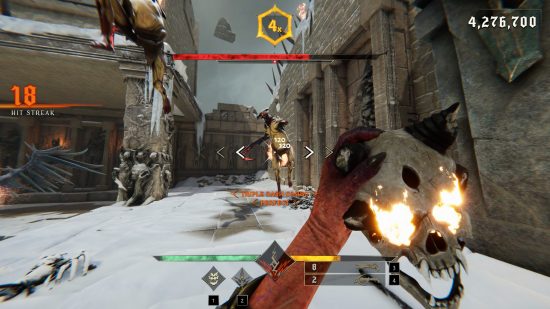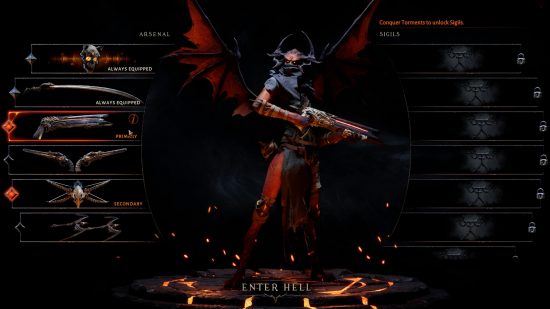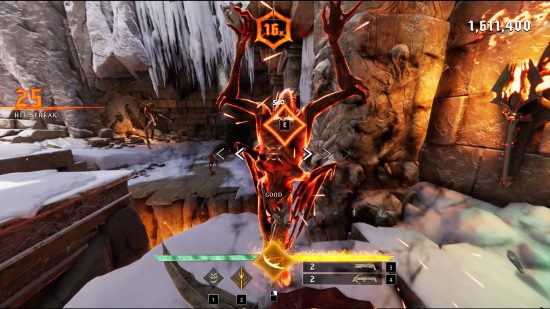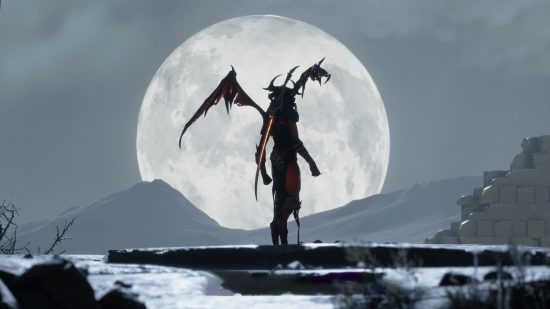Our Verdict
The elements are there to create something truly special, but right now Metal: Hellsinger feels more like a Doom Eternal mod than it does a standalone title.
Metal: Hellsinger takes you on a journey through Hell as you blast your way through waves of demons to the beat of a metal soundtrack. We already know this formula works – after all, Doom Eternal was our Game of the Year in 2020 – but Metal: Hellsinger adds a musical twist to the mix. Similarly to BPM: Bullets Per Minute, you’re incentivised to time your actions to the beat of the song – the more in sync you are with the music, the more damage you deal. But does this mechanic do enough to separate Metal: Hellsinger from its influences?
Narrated by Troy Baker, Metal: Hellsinger tells the story of the Unknown, a demon on a quest to reclaim her voice from the Red Judge, ruler of the Hells. Though Baker’s cowboy impression is fantastic, it’s not enough to make the story interesting. To cut a long story short, Unknown is an unstoppable force who goes to great lengths to get what she wants.
You can’t survive in this game without building up a hit streak, and the only way to do that is to efficiently kill enemies to the beat of the track. Metal: Hellsinger keeps you focussed on this by avoiding – intentionally, I think – intricate level design and unique enemy types. You’ll rarely find that you need to think too hard about your next move, and this keeps you immersed in the music.
Metal: Hellsinger can get away with this basic gameplay loop thanks to its satisfying combat. The game is filled with huge arenas, giving you the space to glide through the air as you learn just how agile your character is. While you can’t technically fly, you can keep your character airborne for long periods of time by correctly timing your dashes and jumps. This combines well with your sword – weaving in and out of groups of demons, taking them out with a quick slash as you zip across the battlefield, is thrilling.
It’s not all chaos. There are plenty of opportunities to take a breather between ripping and tearing. If you’ve taken some damage, you can ‘Slaughter’ glowing enemies – much like Doom’s glory kill system, this sees you to pull demons apart in especially gruesome ways and refills your health. Each weapon has its own Ultimate ability along with a separate Ultimate meter, and in theory you’ll want to keep these in mind for a coordinated attack against specific enemy types, but this level of strategy is generally unnecessary outside of the hardest difficulty mode.
So this is how it goes throughout the three-hour campaign: clear a room filled with bullet-sponge demons, follow the glowing red marker on your map to find another, clear them out too, and repeat until you fight the final boss. It sounds tedious, and it would be if not for the headline feature. Every action is synced to the beat of the music, even reloads. You’ll experience plenty of special moments when your attacks line up so well with the song that it feels scripted.
These moments occur as you get to grips with the rhythm mechanic, and learn to perfectly connect the lines as they converge in the middle of the screen. I’ve been playing classic ‘80s metal tracks on my guitar since I was a teen, so timing my actions to the rhythm of the soundtrack came quite easily – Metal: Hellsinger offers three difficulty modes, but if you’re musically inclined, you may want to start on the hardest right away. I only failed a mission once during the campaign, against a boss that requires you to think about where you’re firing your weapon.
The campaign is very brief, but it may be just as well that it doesn’t get a chance to outstay its welcome, as my main criticisms are to do with an overall lack of variety in the experience. It would’ve been interesting to see how songs with a variety of fast and slow passages might’ve affected the gameplay – some longer pauses between actions might’ve given players space to think about what to do next, and enabled the devs to design more challenging fights. Likewise, more up-tempo sequences could’ve been used to deter hesitation and reward instinctive blasting, to really heighten the tension and the adrenaline.
The flatness of the combat is reflected in the weapon selection. By default, you begin each mission with a skull that acts as a pistol, and a sword for melee combat. You can also select two additional weapons, Sigils (see below), and Hit Streak Boons at the loadout screen before diving into a level. Don’t expect any RPGs or plasma guns to juggle, though – instead you’re stuck with twin pistols, shotguns, and a crossbow, all of which behave very similarly to one another rather than feeling like unique tools to experiment with. But again, the enemy types generally don’t require much variety.
To pad out the playtime, it’s clear that this game has been designed for multiple playthroughs right from the start. After completing the first mission, you gain access to three challenges which only take a few minutes to complete. These challenges hold powerful Sigils which make you significantly stronger without introducing any negative effects – they range from protecting your hit streak several times, to adding more ammo to your weapons. The only problem is that unless you’re going for high scores on the leaderboard, you won’t ever feel the need to become stronger.
The replayability of this game is also going to depend on how much you enjoy the original soundtrack. I don’t mind listening to it on its own, but I feel no urge to experience it again by replaying a level. Would that change if the soundtrack featured songs from prominent metal bands instead? Absolutely, but the music almost certainly needs to be structured in a particular way to suit the gameplay, and that’s not to mention the licensing issues, so there’s probably no chance we’ll get to blow up demons in sync to your favourite big-name metal bands any time soon.
Metal: Hellsinger, like BPM, feels like an exciting proof of concept for the rhythm FPS formula, as well as a perfect example of why it needs both expansion and refinement to see its true potential. The short campaign gives players a taste of what this new subgenre has to offer, and while there’s some post-game content to get through, it’s clear there’s so much more the developer could do in a bigger potential sequel.




